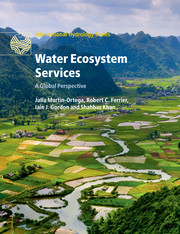Book contents
- Frontmatter
- Contents
- List of contributors
- Preface
- 1 Introduction
- 2 What defines ecosystem services-based approaches?
- Part I Addressing global challenges
- Part II Applying frameworks for water management and biodiversity conservation under an ecosystem services-based approach
- 6 Using ecosystem services-based approaches in Integrated Water Resources Management: perspectives from the developing world
- 7 Implementation of the European Water Framework Directive: what does taking an ecosystem services-based approach add?
- 8 How useful to biodiversity conservation are ecosystem services-based approaches?
- Part III Assessing water ecosystem services
- Part IV Broadening the perspective
- Index
- Plate Section
- References
6 - Using ecosystem services-based approaches in Integrated Water Resources Management: perspectives from the developing world
from Part II - Applying frameworks for water management and biodiversity conservation under an ecosystem services-based approach
Published online by Cambridge University Press: 05 May 2015
- Frontmatter
- Contents
- List of contributors
- Preface
- 1 Introduction
- 2 What defines ecosystem services-based approaches?
- Part I Addressing global challenges
- Part II Applying frameworks for water management and biodiversity conservation under an ecosystem services-based approach
- 6 Using ecosystem services-based approaches in Integrated Water Resources Management: perspectives from the developing world
- 7 Implementation of the European Water Framework Directive: what does taking an ecosystem services-based approach add?
- 8 How useful to biodiversity conservation are ecosystem services-based approaches?
- Part III Assessing water ecosystem services
- Part IV Broadening the perspective
- Index
- Plate Section
- References
Summary
6.1 INTRODUCTION
Integrated Water Resources Management is a normative water management paradigm, widely applied at river basin and country level, which ‘promotes the co-ordinated development and management of water, land and related resources, in order to maximise the resultant economic and social welfare in an equitable manner without compromising the sustainability of vital ecosystems’ (Global Water Partnership 2000, p.22). In other words, the paradigm recognises, and tries to reconcile, the many competing uses of freshwater: water for human/domestic use, agriculture and industrial and energy production, and natural ecosystems. Although the water needs of natural ecosystems are amply recognised in Integrated Water Resources Management theory (Global Water Partnership 2000), in practice they are sacrificed in favour of productive water uses – especially in developing countries.
Every year more and more water is withdrawn from the hydrological cycle for productive purposes. As a result, the resource is increasingly commoditised and disputed. The competition for water is also more global than ever, which has led to frequent instances of land and water grabbing (Woodhouse 2012). In this context of international competition, the sidelining of natural ecosystems in water resources management is likely to be exacerbated. This will amplify the water crisis even further, given the central role of natural ecosystems in the provision, regulation, and recycling of water resources; according to the Millennium Ecosystem Assessment, forest and mountain ecosystems are the sources of 85% of the world's total freshwater runoff (Millennium Ecosystem Assessment 2005, p.167).
We argue that ecosystem services-based approaches can encourage Integrated Water Resources Management practice to pay adequate attention to the water needs of natural ecosystems, i.e. their water requirements for provisioning, regulating, supporting, and cultural services as well as the maintenance of the overall ecosystem health. Because natural ecosystems themselves are the major users of the world's freshwater resources, effective implementation of Integrated Water Resources Management is needed to sustain and enhance the services derived from these ecosystems.
Information
- Type
- Chapter
- Information
- Water Ecosystem ServicesA Global Perspective, pp. 49 - 56Publisher: Cambridge University PressPrint publication year: 2015
References
Accessibility standard: Unknown
Why this information is here
This section outlines the accessibility features of this content - including support for screen readers, full keyboard navigation and high-contrast display options. This may not be relevant for you.Accessibility Information
- 3
- Cited by
